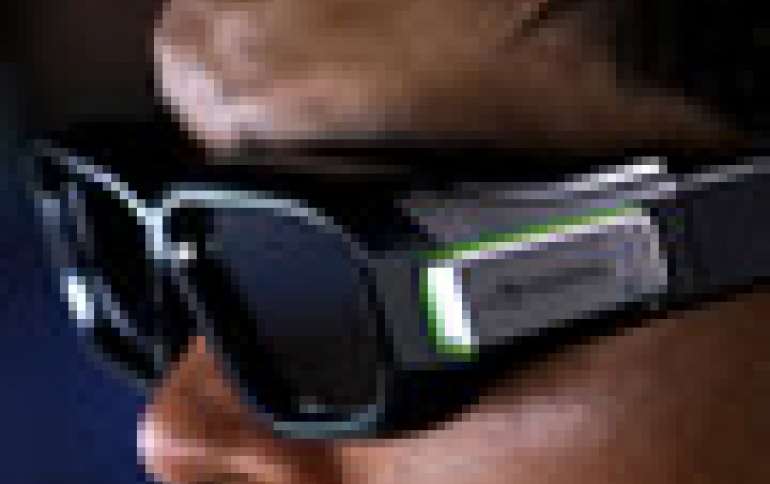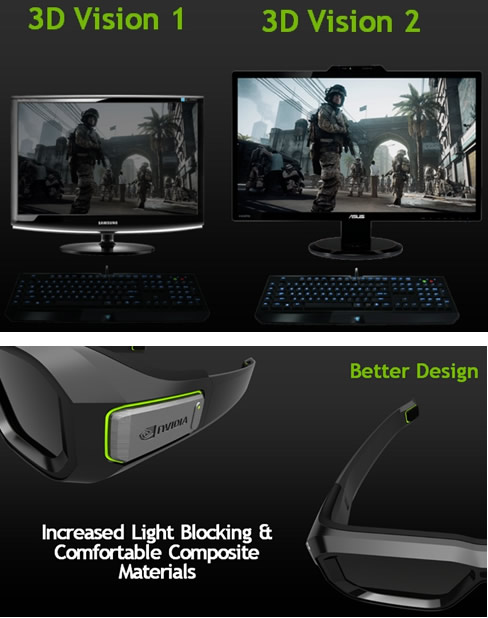
Nvidia Announces 3D Vision 2
Since NVIDIA launched its 3D Vision 3D stereoscopic solution in 2009, 3D gaming on the PC has been steadily rising in popularity. Today, NVIDIA announced 3D Vision 2, a new range of panels and glasses that increases the brightness of 3D images by up to 2 times.
At the heart of 3D Vision 2 is a new technology called NVIDIA 3D LightBoost, a technology that lets monitors go beyond their standard level of brightness when used in 3D mode. Nvidia claims that this compensates for the loss of light from the LCD lenses shuttering, making the 3D image feel almost as bright as a standard 2D image.
3D Vision 2 is a huge improvement over its predecessor. Thanks to larger panels and 3D LightBoost, the image is bigger and brighter. Environment lighting is improved too, making the keyboard easy to read.

In addition to increased screen brightness, 3D LightBoost monitors also increase environmental lighting. Currently, the 3D vision glasses are closed in both eyes during right-to-left and left-to-right transitions. With the new 3D LightBoost monitors, the backlight is switched off during frame transitions and the glasses stay open longer. This brightens up not only the image but also the overall environment, making the keyboard much more readable. This is great for those who play games such as World of Warcraft that require lots of keystrokes and macros.
The first NVIDIA 3D LightBoost-certified desktop display is the ASUS VG278H, a 27-inch LED full HD (1920x1080) monitor, featuring a 3D HDMI 1.4 input, as well as a Dual-link DVI input for full HD 1080p 3D gaming. ASUS' exclusive Trace-Free II Technology features 120Hz refresh rates and 2ms response times. Expected to be available by the end of October 2011, the ASUS VG278H includes NVIDIA 3D Vision 2 glasses and is priced at $699 (USD MSRP).
Additional NVIDIA 3D LightBoost-compatible displays from Acer and BenQ are expected to ship in the coming months. NVIDIA 3D LightBoost compatible notebooks include several Toshiba models -- Satellite P770/P775, Dynabook Satellite T572, Dynabook T572, and the Qosmio X770/X775 -- with others expected in the coming months.
As part of 3D Vision 2, NVIDIA is introducing a newly redesigned set of glasses with 20% larger lenses and improved ergonomics. The new design slims down the earpiece, making the glasses comfortable to wear with gaming headsets for hours of 3D gaming. A light blocker has been added to the top side of the lenses to cut off unwanted outside light. Perhaps best of all, the improved glasses will stay at the same price point at $149 for the glasses + emitter kit and $99 for the glasses.
While the original 3D Vision kit was geared more toward enthusiasts, 3D Vision 2 feels more mature, polished, and at $149, accessible to mainstream PC gamers.
3D Vision 2 is a huge improvement over its predecessor. Thanks to larger panels and 3D LightBoost, the image is bigger and brighter. Environment lighting is improved too, making the keyboard easy to read.

In addition to increased screen brightness, 3D LightBoost monitors also increase environmental lighting. Currently, the 3D vision glasses are closed in both eyes during right-to-left and left-to-right transitions. With the new 3D LightBoost monitors, the backlight is switched off during frame transitions and the glasses stay open longer. This brightens up not only the image but also the overall environment, making the keyboard much more readable. This is great for those who play games such as World of Warcraft that require lots of keystrokes and macros.
The first NVIDIA 3D LightBoost-certified desktop display is the ASUS VG278H, a 27-inch LED full HD (1920x1080) monitor, featuring a 3D HDMI 1.4 input, as well as a Dual-link DVI input for full HD 1080p 3D gaming. ASUS' exclusive Trace-Free II Technology features 120Hz refresh rates and 2ms response times. Expected to be available by the end of October 2011, the ASUS VG278H includes NVIDIA 3D Vision 2 glasses and is priced at $699 (USD MSRP).
Additional NVIDIA 3D LightBoost-compatible displays from Acer and BenQ are expected to ship in the coming months. NVIDIA 3D LightBoost compatible notebooks include several Toshiba models -- Satellite P770/P775, Dynabook Satellite T572, Dynabook T572, and the Qosmio X770/X775 -- with others expected in the coming months.
As part of 3D Vision 2, NVIDIA is introducing a newly redesigned set of glasses with 20% larger lenses and improved ergonomics. The new design slims down the earpiece, making the glasses comfortable to wear with gaming headsets for hours of 3D gaming. A light blocker has been added to the top side of the lenses to cut off unwanted outside light. Perhaps best of all, the improved glasses will stay at the same price point at $149 for the glasses + emitter kit and $99 for the glasses.
While the original 3D Vision kit was geared more toward enthusiasts, 3D Vision 2 feels more mature, polished, and at $149, accessible to mainstream PC gamers.




















